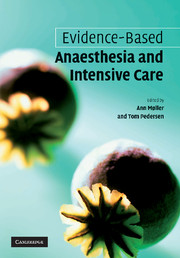
- Cited by 1
-
Cited byCrossref Citations
This Book has been cited by the following publications. This list is generated based on data provided by Crossref.
Herling, Suzanne Forsyth Dreijer, Bjørn Wrist Lam, Gitte Thomsen, Thordis and Møller, Ann Merete 2017. Total intravenous anaesthesia versus inhalational anaesthesia for adults undergoing transabdominal robotic assisted laparoscopic surgery. Cochrane Database of Systematic Reviews, Vol. 2017, Issue. 4,
- Publisher:
- Cambridge University Press
- Online publication date:
- September 2009
- Print publication year:
- 2006
- Online ISBN:
- 9780511544613


